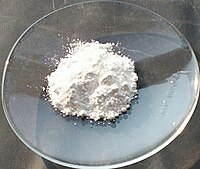Zinc oxide
 |
|
| Names | |
|---|---|
| Other names
Zinc white, calamine, philosopher's wool, Chinese white, flowers of zinc
|
|
| Identifiers | |
|
1314-13-2 |
|
| ChEBI |
CHEBI:36560 |
| ChEMBL |
ChEMBL1201128 |
| ChemSpider |
14122 |
| ECHA InfoCard | 100.013.839 |
| EC Number | 215-222-5 |
| PubChem | 14806 |
| RTECS number | ZH4810000 |
|
|
| Properties | |
| ZnO | |
| Molar mass | 81.38 g/mol |
| Appearance | White solid |
| Odor | Odorless |
| Density | 5.606 g/cm3 |
| Melting point | 1,975 °C (3,587 °F; 2,248 K) (decomposes) |
| Boiling point | 1,975 °C (3,587 °F; 2,248 K) (decomposes) |
| 0.0004% (17.8°C) | |
| Band gap | 3.3 eV (direct) |
| −46.0·10−6 cm3/mol | |
|
Refractive index (nD)
|
2.0041 |
| Structure | |
| Wurtzite | |
| C6v4-P63mc | |
|
a = 3.25 Å, c = 5.2 Å
|
|
| Tetrahedral | |
| Thermochemistry | |
|
Std molar
entropy (S |
43.9 J·K−1mol−1 |
|
Std enthalpy of
formation (ΔfH |
-348.0 kJ/mol |
| Pharmacology | |
| QA07XA91 (WHO) | |
| Hazards | |
| Safety data sheet | ICSC 0208 |
|
EU classification (DSD)
|
Dangerous for the environment (N) |
| R-phrases | R50/53 |
| S-phrases | S60, S61 |
| NFPA 704 | |
| Flash point | 1,436 °C (2,617 °F; 1,709 K) |
| Lethal dose or concentration (LD, LC): | |
|
LD50 (median dose)
|
240 mg/kg (intraperitoneal, rat) 7950 mg/kg (rat, oral) |
|
LC50 (median concentration)
|
2500 mg/m3 (mouse) |
|
LCLo (lowest published)
|
2500 mg/m3 (guinea pig, 3–4 hr) |
| US health exposure limits (NIOSH): | |
|
PEL (Permissible)
|
TWA 5 mg/m3 (fume) TWA 15 mg/m3 (total dust) TWA 5 mg/m3 (resp dust) |
|
REL (Recommended)
|
Dust: TWA 5 mg/m3 C 15 mg/m3 Fume: TWA 5 mg/m3 ST 10 mg/m3 |
|
IDLH (Immediate danger)
|
500 mg/m3 |
| Related compounds | |
|
Other anions
|
Zinc sulfide Zinc selenide Zinc telluride |
|
Other cations
|
Cadmium oxide Mercury(II) oxide |
|
Except where otherwise noted, data are given for materials in their standard state (at 25 °C [77 °F], 100 kPa).
|
|
|
|
|
| Infobox references | |
Fume: TWA 5 mg/m3 ST 10 mg/m3
Zinc oxide is an inorganic compound with the formula ZnO. ZnO is a white powder that is insoluble in water, and it is widely used as an additive in numerous materials and products including rubbers, plastics, ceramics, glass, cement, lubricants, paints, ointments, adhesives, sealants, pigments, foods, batteries, ferrites, fire retardants, and first-aid tapes. Although it occurs naturally as the mineral zincite, most zinc oxide is produced synthetically.
ZnO is a wide-bandgap semiconductor of the II-VI semiconductor group. The native doping of the semiconductor due to oxygen vacancies or zinc interstitials is n-type. This semiconductor has several favorable properties, including good transparency, high electron mobility, wide bandgap, and strong room-temperature luminescence. Those properties are valuable in emerging applications for: transparent electrodes in liquid crystal displays, energy-saving or heat-protecting windows, and electronics as thin-film transistors and light-emitting diodes.
Pure ZnO is a white powder, but in nature it occurs as the rare mineral zincite, which usually contains manganese and other impurities that confer a yellow to red color.
Crystalline zinc oxide is thermochromic, changing from white to yellow when heated in air and reverting to white on cooling. This color change is caused by a small loss of oxygen to the environment at high temperatures to form the non-stoichiometric Zn1+xO, where at 800 °C, x = 0.00007.
...
Wikipedia

